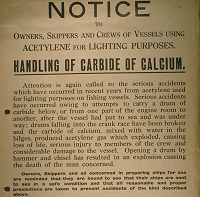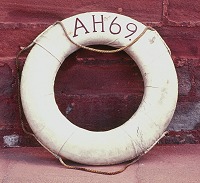Back to start | Life onboard: equipment | Next
Fire and flood

Fire and flood are constant dangers at sea. Fires can be started by faulty wiring or problems with equipment. Even the best maintained vessels could spring a leak. It is important that alarms are fitted and working. These will alert the skipper if the water levels below decks are getting too high. Most boats are fitted with automatic bilge alarms and pumps but it is good practice to carry a spare. Where automatic systems are relied upon, it is even more important that they are regularly checked. Sailing with hatchways open could also cause problems. It is also dangerous to sail with loads unevenly placed, either on deck or in the hold. If the boat was already unstable, water coming onboard would worsen the problem and might make the boat capsize.
By the early 20th century many boats had engines. There were steam, motor and paraffin engines. Fires became a big hazard, particularly in wooden boats. Explosions were also a danger. The fishermen were not always trained in working engines and this added to the problems. In the 1920s and 1930s a chemical called Carbide of Calcium was used to power the lights on some fishing boats. This could blow up or create dangerous gas. The Board of Trade issued a warning leaflet.

Two fishing boats were caught out in 1998 while returning to Fraserburgh after a trip to Rockall. They were the pair-trawlers Sapphire PD285 and Elegance PD33. The wind was westerly and both boats were taking spray over the bows. During the four-hour trip back, the Sapphire gradually pulled ahead until there were around four miles between the boats. At 3.30 pm the skipper of the Sapphire was woken to find the boat listing severely to starboard. He made for the wheelhouse to radio to the Elegance for help but the boat lost electrical power before he could complete the call. He called for everyone to evacuate, but before they could, the boat heeled over and the skipper was swept out of the port window. He managed to reach one of the life rafts (which had released and inflated as designed) and set off some flares. He was later rescued by helicopter. The other four crew-members were drowned. There was an enquiry by the Marine Accident Investigation Branch. It concluded that a number of weathertight doors, mainly on the starboard side, had been left open. This had allowed water to enter. The Sapphire's bilge alarm was not working so the problem was not identified until it was too late.
Back to start | Life onboard: equipment | Next